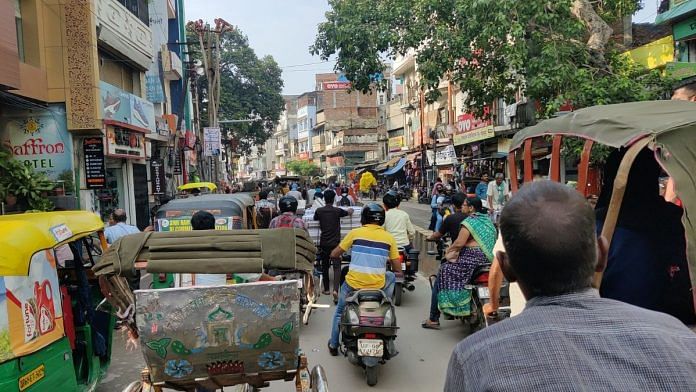Varanasi: Gulshan Kapoor used to climb the walls of the Gyanvapi mosque in just seconds as a child to fetch cricket balls and fallen kites. The expansive open ground next to the mosque near Varanasi’s Kashi Vishwanath temple was his playground.
It was a time when children of Hindus and Muslims used to play and pray together.
Now, the central battle in Varanasi is over who prayed where and until when.
After former Uttar Pradesh chief minister Mulayam Singh Yadav barricaded the mosque in 1993, the grounds emptied of children, and Hindus were restricted from praying at the holy Shringar Gauri wall on the western side of the mosque to only once a year.
Now, they want in.
A clutch of court cases is fighting to challenge and change the status of the mosque that it says was built by Mughal emperor Aurangzeb in 1669 by demolishing a Shiva temple complex.
The three white domes on top of the visible ruins of a sandstone structure never stuck out like a sore thumb back then. But the dilapidating mosque is under attack now. Once the core of Varanasi’s shared cultural and social fabric, it is now just an encroachment.
“We have many visible and invisible gods in the mosque complex. Hindus offered prayers inside the mosque till the Mulayam Singh government blocked our access. So, as per the Places of Worship Act of 1991, the true character of that building is of a temple,” says Jitendra Singh Bishen, Delhi-based founder of Vishwa Vedic Sanatan Sangh, a trust steering some of the cases on the Gyanvapi mosque.
He wrote an open letter on 17 August inviting the Hindu and Muslim sides to solve the mosque dispute in an out-of-court settlement.
But the other lawyers representing the Hindu side dismissed it.
‘I will break the mosque’
Anger gnaws at grain dealer Harihar Pandey when he sees the domes. He’s 77 now, but he’s building a sena (army) of young men to take up cudgels on his behalf.
The anger began in the 1980s, around the same time the Babri Masjid issue in Ayodhya was gathering steam. Discontent spread through the maze of lanes where Hindus would sell Banarasi sarees woven by Muslims, and Muslims would make dresses for Hindu deities. In Varanasi, its impact was felt most in the bustling trade centre that had come up around the Kashi Vishwanath temple and the Gyanvapi mosque complex.
A young Pandey, who came from a family of landlords and was influenced by socialist leaders Ram Manohar Lohia and Raj Narain, drifted toward student politics. His fervour to remove the Gyanvapi mosque from its site started from there.
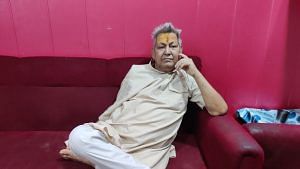
“I could see that the mosque is built over a temple. Every time I used to pass it, it used to make my blood boil. I wanted to remove it,” says Pandey, his forehead smeared with chandan (sandalwood).
Organising meetings and making people aware of the “historical wrongs done to the Hindus” was not enough for him. He decided to move the court, but first, he needed evidence. In his early 40s then, he borrowed a kurta set, skull cap, camera, torch and Army boots from a Muslim friend and risked his life twice to enter the Gyanvapi mosque at night by bribing police officers.
“I had to make my case stronger. All evidence of a temple is inside the mosque itself,” says Pandey, who joined RSS in 1987 and BJP in 1990.
He claims he saw a trishul [trident], Ganesh and other engravings on the walls, which resembled Hindu signs and symbols. However, because he could not operate the camera, he drew them instead.
Pandey even travelled to Hyderabad and Kolkata to collect copies of the Aurangzeb Nama from Muslim libraries to hunt for references to the mosque and temple. But time was running out for him. There was talk of the Places of Worship Act being passed in the Parliament, preventing any new case from being filed on mosque-temple disputes after Babri. The Act states also that the religious character of any place of worship must be maintained as it existed on 15 August 1947, stopping people from raising temple-mosque disputes in court.
He filed the first case on the issue in 1991, just before the Act was passed.
“I demanded the encroached mosque to be demolished and the land be given for the temple. My case is stronger than the cases filed recently,” says Pandey, sipping sugarless tea from a stainless steel glass.
In a sparsely furnished room converted into an office, old Hindi books on Varanasi, the Kashi temple and the Gyanvapi mosque are stuffed in saffron-coloured cabinets. It’s been three decades, and Pandey’s case is still languishing in the Allahabad High Court.
But failing kidneys and a weak body have not diminished his zeal.
“I will break the mosque irrespective of the court or the government’s decision. I am ready to die for this,” he says.
To back him up, his two sons, an income tax lawyer and a property dealer, fund his court fees and the work he does on the side to keep his mission to demolish the mosque alive. His sons are also members of the Vishwa Hindu Parishad and the Bajrang Dal.
“I am creating a bhairon sena (local army) of passionate, dedicated men from Purvanchal. We will go and break the mosque. Just like Babri, we will do it,” he says. The sena, he explains, has so far gathered over 1,000 men between 18 and 38 years old who are devoted to building the temple.
Pandey, however, doesn’t agree with claims made in recent court cases that prayers to Hindu gods used to happen inside the mosque until it was barricaded in 1993.
“No one could go inside the mosque to pray even in the 1980s. Namaz used to happen there. Shringar Gauri was outside the mosque. If I filed my case in 1991 and made no such claim, how can the new petitioners say that prayers used to happen till 1993?”
Also read: Moradabad Muslim massacre 1980: A tale of missing men, memories, Ek Raat Wali Masjid
The story of Shringar Gauri
Saffron-painted brick slabs at a waist-level wall on Gyanvapi’s western perimeter became the starting point for a fight to reclaim the mosque. The wall is sacred for Hindus, considered the abode of Shringar Gauri, the protector of married women.
On the fourth day of Chaitra Navratri, a nine-day festival celebrated in March or April, movable barricades are removed, and a handful of residents with permission from the district administration, put a silver mask of Shringar Gauri on the wall. The narrow passage in front of the wall is smeared with vermillion, with holy chants and temple bells reverberating through the temple and mosque complex.
Since the early 1990s, the state administration has restricted these celebrations to only once a year.
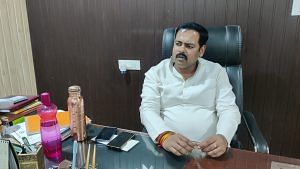
“It was done keeping in mind the communal atmosphere in the country. Prayers were restricted, and barricades were put up to save the Constitution. Netaji [Mulayam] did it to maintain peace,” says Ashutosh Sinha, MLC and Samajwadi Party (SP) member, Varanasi.
The ripples of the Babri masjid demolition were also felt strongly in Varanasi. The chants of Kashi (Gyanvapi mosque) and Mathura (Shahi Idgah mosque) as the next targets were shrill. Fearing damage to the Gyanvapi mosque, the SP government put up bamboo barricades and stationed security personnel around the complex, which until then was open to all.
The barricades grew taller and stronger as the years passed. Iron replaced bamboo, and 12 feet rods gave way to 20 feet ones by the early 2000s. The Shringar Gauri wall lies outside these iron barricades and falls into the temple compound. In 2021, five women petitioned the courts, questioning the logic of this arrangement. If the Shringar Gauri prayer can happen once a year, why not throughout?
“My ancestors used to pray inside the complex. We want to follow them,” says Rakhi Singh, the Delhi-based lead petitioner in the case. It was on her behalf that Bishen proposed they arrive at a settlement out of court, but the other four women and their lawyers rejected it.
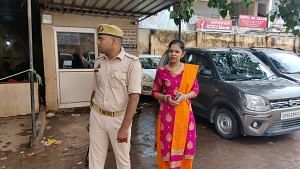
Their main demand in court, however, is not limited to Shringar Gauri. It has become the entry point for Hindus to overrule the hurdle of the Places of Worship Act.
“The civil suit does not fall under the Act because we are not demanding the mosque land or ownership. We are simply saying that the women want the right to pray inside,” says Bishen, who is also Singh’s uncle.
Also read:
Was the mosque once a temple?
The petitioners’ lawyers claim that before barricades were put up, the Shringar Gauri deity was inside the mosque compound, and their ancestors used to offer prayers there to her, Hanuman, Ganesha, and Nandi. They claim that after the barricades came up, Shringar Gauri was destroyed, and prayers started to be held outside the wall instead.
“Earlier, there was no barricade. So, all the idols were on all the four directions of the mosque in the compound. Our case is that our gods Hanuman, Ganesh, and Shringar Gauri were inside barricades but were pushed out eventually,” says Vishnu Shankar Jain, the advocate representing four of five women in the case.
He insists that the Vyas family [Mahants of the mosque area] was doing pooja in the basement till 1993 and was ousted from the area that same year. “Our case is that all of this should be restored,” he adds.
Through this, the petitioners are seeking entry inside the mosque compound.
To bolster the assertion that what is now a mosque was once a Hindu place of worship, Jain adds that no namaz was offered in the complex then.
“We think there was no namaz offered at that time. This issue is not only about barricading. It is about the title. We have said in our prayer that we used to pray to visible and invisible deities.”
Though the case is limited to the individual rights of the five women to pray inside the mosque, it has, so far, skirted the hurdle of maintainability of the case under the Places of Worship Act, which cases of title dispute often face.
The mosque committee, Anjuman Intezamia Masjid, however, dismisses the claims by the Hindus that prayers used to be offered inside the mosque compound and namaz wasn’t.
Pulling out a 1995 edition of a newspaper-size magazine named Vandematram, Syed Mohammad Yaseen, joint secretary of the committee, flips through pages filled with photographs of the Gyanvapi mosque before it was barricaded. Several photographs show the mosque packed with men offering namaz.
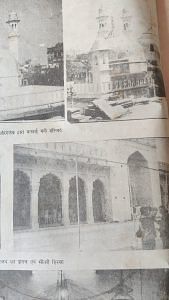
Besides, cases filed in the courts before 1947 also uphold the rights of Muslims to offer namaz in the mosque. In 2016, the committee collected maps and land records of 1883-84 from the district collectorate, which states that “Jama Masjid is under possession of the Muslims”.
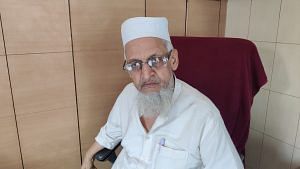
“What proof do they have when they say that namaz was not offered there or that Hindus used to pray there?” says Yaseen.
He also dismisses claims that Hanuman, Nandi and Shringar Gauri were ever inside the mosque complex.
“This is a lie. These were never inside the mosque. They can pray to these gods and Shringar Gauri all year round. The Muslims don’t have any objection. This is all outside the mosque compound and was always outside the mosque,” says Yaseen.
At the heart of the debate is the character of the place of worship. The mosque committee claims that Gyanvapi is their main mosque—their Jama Masjid. The Hindu parties claim they offered prayers to Hindu gods inside the mosque until it was barricaded. That is why, they argue, it deserves the status of a temple under the Places of Worship Act of 1991.
In Varanasi’s civil and district courts, about 20 cases have been filed since 2021 by people questioning the sanctity of the Gyanvapi mosque. While one case demands that Muslims be stopped from entering the mosque, another asks for the premise to be sealed to preserve artefacts and objects that petitioners allege are ruins of the Hindu temple.
Rakhi Singh and the other four women, in a cleverly-worded civil suit, demanded the right to pray to Shringar Gauri and “visible and invisible” gods “within the old temple complex” (i.e. the mosque) throughout the year. The court ordered a survey of the mosque by the Archaeological Survey of India (ASI), which is currently underway ongoing.
As the two sides debate the legality of the issue, the mosque has become a fortress. Cocooned in the Kashi Vishwanath Temple compound, men and women wearing white and blue ASI t-shirts, caps, and gloves attract Hindu tourists. They can be seen from the high metal barricades dusting the sand off rocks and engravings with their excavation brushes.
“This is our temple. The Muslims have occupied it,” says one of the two women circling the mosque as she pulls out a small vermillion pouch and discreetly pushes it inside the metal rods before quickly walking away.
Divide between Hindus
In this tangle of claims and counterclaims, childhood memories and family tales, history and empirical evidence, not all Hindu devotees agree on what is inside the mosque. A section of people ThePrint spoke to were confident that they saw idols and witnessed prayers inside the mosque, while another group of people denied it.
History books and academic papers present ample evidence that the place where the Gyanvapi mosque today stands was an ancient temple. The ruins of a wall behind the mosque and surveys conducted earlier give a glimpse into it.
Rana PB Singh, former professor of cultural landscapes and heritage studies at Banaras Hindu University, also elaborates on how a temple stood on the disputed land before. He cites the works of Saqi Mustaad Khan, the author of Ma’sîr-i-Ãlamgîrî, which notes that Aurangzeb issued a farman (order) on 9 April 1669 to demolish the “schools and temples of the infidels”. Soon after, Singh notes in his 2022 paper, “it was reported that, in accordance with the emperor’s command, his officers had demolished the temple of Vishvanatha at Kashi (Varanasi) on 18 April 1669.”
In her book Banaras: City of Light, US scholar Diana L Eck also concludes that the history of the previous Shiva temples is, in a nutshell, the history of Varanasi over the past thousand years – a tale of repeated destruction and desecration. “One wall of the old temple is still standing, set like a Hindu ornament in the matrix of the mosque,” she writes.
One of the claims of the Hindus is that a room in the basement of the mosque was in possession of the Vyas family. Somnath Vyas, a Mahant from 1968 till his death in 2000, was also a co-petitioner with Pandey in the 1991 case. He handed over his Mahant responsibilities to nephews Shailendra Kumar Pathak and Jitendra Kumar Pathak.
In 2016, during the construction of the Kashi Vishwanath temple corridor, the Vyas family was forced out of the area around the mosque that they owned. Living on the outskirts of Varanasi now, Shailendra explains that even though the basement was their property, no pooja used to happen there.
“The room was used as a store room to keep bamboo and other material needed in the Ram Katha that happened at the open ground annually. We used to open the room for two days a year. Once, to take out the material, and then to keep the material back after nine days,” adds Shailendra.
After the barricading in 1993, the Vyas family lost access to the room. Moreover, around 2005-06, the door broke and could never be fixed again. Pathak adds that the room, known as garbhgriha, was an unused area devoid of hidden idols or a Shivling.
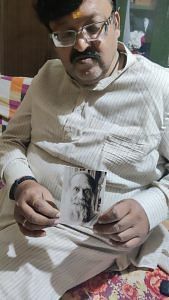
“It was a legend that was transferred for generations. Our ancestors passed on the belief that there used to be an old temple many centuries ago, so we used to go light a diya there. No pooja used to happen there. For 400 years, that place has been a mosque,” says Shailendra.
Even the Shringar Gauri wall, he says, was not a popular praying site as it is made to be now. His uncle, Chnadrakant Vyas, used to be the pujari (priest) at Shringar Gauri, and only a handful of local women knew about it.
The Mahant of the Kashi Vishwanath Temple, Rajendra Tiwari, whose family took care of it for over 20 generations, says proving prayers happened inside the mosque will be a challenge in court.
His family managed the temple until the government took over in 1983.
Before the two holy shrines were divided with barricades, the temple and the mosque had a common narrow entry. The Muslim devotees could go to the mosque, and the Hindus could access the temple a few steps ahead.
While Tiwari does not doubt that the place where the mosque today stands was once a temple, he says that Hindus offered prayers at the temple, not the mosque.
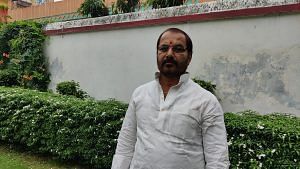
“There is no evidence that pooja happened at the mosque. If you ask the petitioners to point out the locations where the prayers used to happen, they will not be able to spot them.”
The hue and cry about the discoveries made by the survey teams, Tiwari adds, do not prove that Hindu prayers happened inside the mosque.
“Last year, the Hindus made noise about a Shivling being found in the wuzu khana in the mosque. Not every stone pole is a Shivling. Besides, the Shivling doesn’t have a hole, and its base is missing. This is propaganda to spread misinformation.”
Also read: There are 3 claims to Ayodhya — law, memory & faith. It’s not a simple Hindu-Muslim dispute
Divisive politics
The Hindu party in the court is confident that the case is tilting in their favour.
“On the last day of hearing in ASI survey matter before Allahabad High Court in July, the additional advocate general of the Uttar Pradesh government said that regular pooja used to happen at the disputed side before 1993,” says Saurabh Tiwari, Rakhi Singh’s advocate.
He adds that the maintainability pleas and the stays by the Muslim party are being overruled in the courts. At least seven are clubbed in the district court of Varanasi and will be heard together, he explains.
Jain adds that he is also pursuing six cases in the courts of Varanasi.
The cases are adding momentum to social groups that have long raised questions about the Gyanvapi mosque. Kapoor, who was earlier with the Shiv Sena and is now a BJP member, has printed a handful of sepia photographs of the mosque complex into a booklet called Dharm Raksha Pradarshani: Gyanvapi Ka Sach Aur Saboot.
A Gujarati ascetic, Anil Shastri, who made Varanasi his base in the 1980s and joined a social group Gyanvapi Mukti Mahaparishad (GMM), says his annual pledge at Shringar Gauri is finally showing results.
“It is my mission to free the temple from the mosque. I introduced two of the women petitioners to the lawyers. After the case was filed, I took the women for Shringar Gauri darshan,” says Shastri, who spent his youth agitating against the mosque.
The founder of GMM, Shiv Kumar Shukla, adds that he, along with other devotees, used to go for jal abhishek of the Shringar Gauri, and clashes with the police were inevitable as a result.
“The police would arrest me every year at Shivratri and before Saawan. We wanted Shringar Gauri to be known around the world. We should be able to pray there throughout the year,” says Shukla.
This divisive politics, says Vishwambhar Nath Mishra, head of Varanasi-based NGO Sankat Mochan Foundation, is polarising the city.
“Varanasi is the prototype model of the city. Hindus praying inside a mosque is unheard of. No one from the Hindu samaj is coming forward to make this claim. And if you now say that the Swayambhu Shivling is buried under the mosque, then what have Hindus been praying to for 300 years in the Kashi Vishwanath temple?” he asks.
Also read: Waqf boards are India’s big urban landlords. But whose interest are they serving?
Fight for justice or politics of division?
In the confined alleyways surrounding the two holy shrines, stories of the buried temple and its prayer gatherings run rampant. At tea stalls and shops selling pooja material, Hindu devotees are positive that justice will finally be served to them. The survey, they say, is taking them a step closer to fixing historical wrongs.
“This issue of Gyanvapi is not new. This time, because of the BJP government, a survey has found remains of the Hindu temple. This should not lead to any fight. Whatever the survey teams find, the decision should go in favour of that religion,” says Neeraj Maurya, a resident of Ishwargangi Kund.
In the Muslim-dominated weavers’ colony, Qazi Sadulla Pura of Varanasi, residents say that the vagaries in how the cases on Gyanvapi are turning in the courts are breaking the city’s harmony.
“Don’t divide us for politics. Banaras is known for how its Hindus and Muslims live and work together. No one’s religious place should be harmed,” says Shameer Riyaz, a weaver.
Loud clicking sounds of the power loom fill the lanes from behind closed wooden windows of the colony. Abdul Rasheed Ansari, a weaver, points to a shop under a mosque.
“This shop on the ground floor of the mosque is run by a Hindu. He keeps idols here and prays every day. Does this convert the whole building into a mosque?”
(Edited by Zoya Bhatti)


